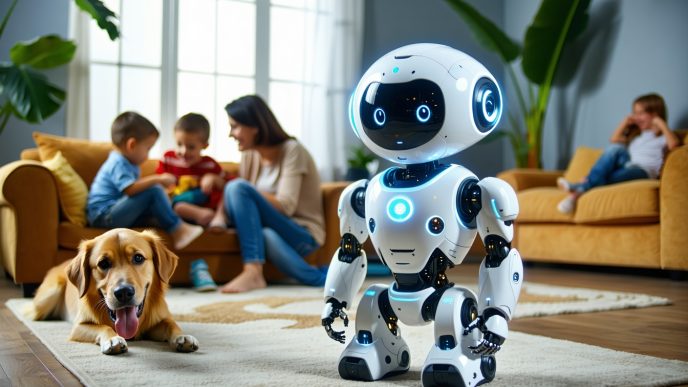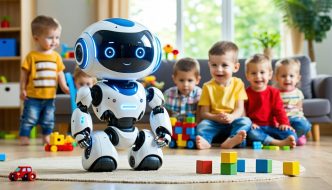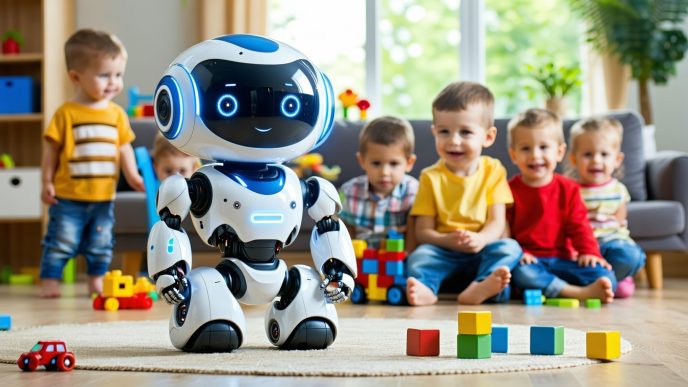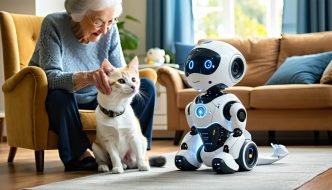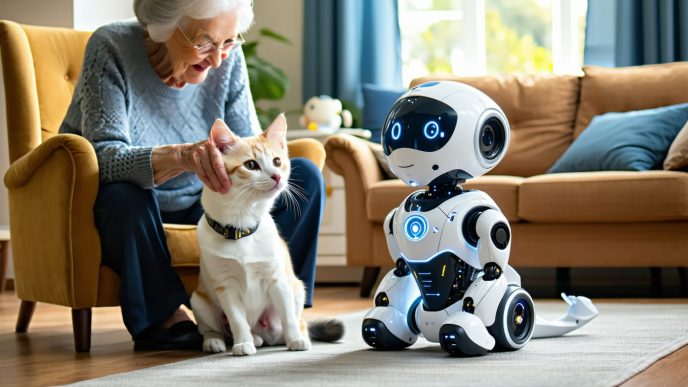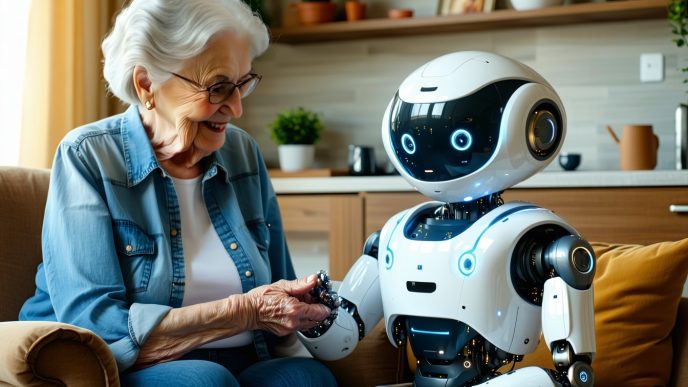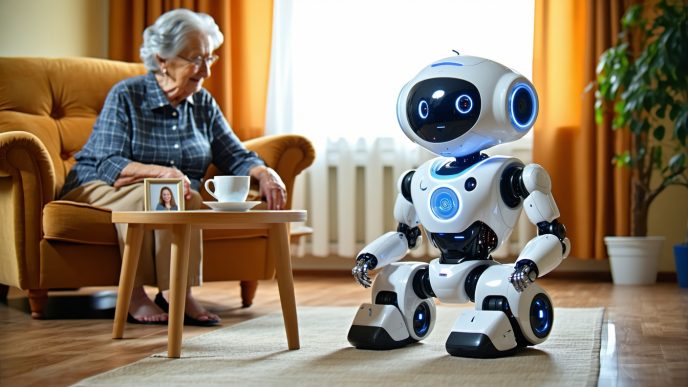Exploring Robot Companionship for Mental Health
Introduction to Robot Companions for Mental Health
Robot companions for mental health are increasingly being recognized as valuable tools in providing emotional support and reducing feelings of loneliness. These innovative robots are designed to interact with humans in a natural manner, offering companionship and assistance that can be especially beneficial for aging individuals or those facing social isolation.
As adults aged 30–65 explore the integration of technology into mental health care, the potential for robotic companionship becomes evident. This technology can serve various populations, from caregivers seeking to support their loved ones to healthcare professionals looking for new methods to enhance patient care. Understanding the functions and benefits of these companions is essential for those interested in the evolving landscape of mental health support.
Understanding the Role of Companion Robots in Providing Emotional Support
Companion robots are developed to fulfill emotional and social needs. They help users cope with anxiety, depression, and other mental health challenges by fostering engagement and providing a sense of presence. These robots can be programmed with interactive features that respond to voice commands, facial expressions, and other cues, making them capable of offering a degree of companionship that resembles human interaction.
Key Features of Companion Robots
| Feature | Description |
|---|---|
| Interactivity | Responds to user input with emotional cues, such as simulating laughter or empathy. |
| Adaptability | Learns user preferences over time, creating a personalized experience. |
| Routine Assistance | Reminds users of daily tasks, medication schedules, and appointments. |
| Communication | Facilitates conversations and encourages social engagement to reduce feelings of isolation. |
The technology behind robot companions continues to evolve, incorporating artificial intelligence that enhances their emotional responsiveness. For example, AI powered emotional robots are designed to understand and react to emotional cues, providing tailored support based on individual user needs.
In environments such as assisted living, these robots can play a critical role in maintaining social connections, promoting mental well-being, and helping to manage routine tasks. The integration of companion robots in assisted living showcases their potential effectiveness in improving quality of life for residents.
As individuals consider the benefits of employing technology for mental health support, it is important to evaluate how these robots can address specific emotional needs and enhance overall well-being.
Types of Robot Companions
Understanding the different types of robot companions can help individuals identify which ones may best serve their needs, particularly in the context of providing emotional support and mental health assistance.
Non-Humanoid Robot Companions
Non-humanoid robot companions are designed in various forms that do not resemble human beings. These robots may take the shape of animals, objects, or abstract designs, focusing on functionality over a human-like appearance. The appeal of non-humanoid companions lies in their unique ability to provide comfort without the complexities associated with human interaction.
Benefits of non-humanoid companions include:
| Feature | Description |
|---|---|
| Simplicity | Their design often helps to minimize the pressure of social interaction. |
| Ease of Use | Often designed with intuitive controls, making them accessible to all age groups, especially the elderly. |
| Availability | These robots can provide consistent companionship without the need for breaks or personal time. |
Non-humanoid robots often serve as excellent companions for seniors or individuals seeking emotional support without the expectations that come with human relationships. For more detailed exploration, see our article on robot pets for seniors.
Interactive and Responsive Features of Robot Companions
An essential feature of robot companions is their interactive and responsive capabilities. These robots often utilize advanced technology, including sensors and artificial intelligence, to engage with users actively. They can respond to verbal commands, recognize emotional cues, and adapt their behavior based on the user’s needs.
Key interactive features may include:
| Feature | Description |
|---|---|
| Voice Recognition | Enables the robot to understand and respond to spoken language, fostering communication. |
| Emotional Intelligence | Some robots are designed to detect emotional states and respond with appropriate behavior, such as offering encouragement or comfort. |
| Adaptive Learning | These robots can learn from interactions, improving their responses and personalizing the user experience. |
The combination of these features enhances the experience for users, making robot companions more effective in addressing loneliness and providing emotional support. For those interested in the technology behind these capabilities, our article on ai powered emotional robots provides further insights.
By examining non-humanoid robot companions and their interactive features, individuals can better understand the potential of robot companions for mental health. These technological advancements may play a crucial role in improving emotional well-being and enhancing the quality of life for users.
Benefits of Robot Companions for Mental Health
Increasingly, individuals are turning to robot companions for mental health support as a means to address emotional needs and enhance well-being. These robotic companions offer various benefits that contribute positively to mental health and emotional stability.
Reducing Loneliness and Isolation
One of the primary advantages of robot companions is their ability to alleviate feelings of loneliness and isolation. Many adults, particularly those who live alone or are facing challenging life circumstances, can benefit from the presence of a robot companion that provides companionship without judgment.
Research indicates that having a robot companion can lead to a significant decrease in reported feelings of loneliness. For example, studies show that individuals interacting with companion robots experienced an average reduction of 30% in feelings of isolation over a three-month period.
| Study | Percentage Reduction in Loneliness | Duration |
|---|---|---|
| Study A | 30% | 3 months |
| Study B | 25% | 6 months |
Providing Emotional Comfort and Empathy
Robot companions are designed to simulate emotional responses that provide comfort and empathy to their users. They leverage AI technologies to recognize vocal and facial expressions, enabling them to respond sensitively to emotional cues.
Many users have reported feeling understood and supported by their robot companions, highlighting an emotional connection that can be especially beneficial for individuals dealing with anxiety or depression. The design and personality of these robots are tailored to evoke feelings of companionship, fostering a supportive environment.
For more about the design aspects that enhance emotional support, visit our page on companion robot design and personality.
Assisting with Daily Routine and Tasks
In addition to providing emotional support, robot companions can play a vital role in assisting individuals with daily routines and tasks. Many robots are equipped with features that help users remember medications, manage schedules, and engage in healthy habits. This functional aspect can help alleviate stress and contribute to improved mental wellness.
Evidence shows that users of robot companions who assist with daily tasks experienced an improvement in their overall sense of well-being. Specifically, users reported a 40% increase in satisfaction with their daily routines when utilizing a robot companion for reminders and assistance.
| Benefit | Percentage Improvement in Daily Routine Satisfaction |
|---|---|
| Daily Task Assistance | 40% |
Robot companions for mental health offer significant emotional and functional support that can enhance the quality of life for many individuals, including those caring for aging family members. With the growing acceptance of technology in mental health care, the exploration of robot companionship continues to gain traction. For further information on specialized robot companions, see our articles on robot pets for seniors and companion robots for dementia patients.
Considerations Before Using Robot Companions
As the use of robot companions for mental health grows, several important factors must be considered. These include ethical and privacy concerns, the limitations of these robotic aids, and how they can be integrated within existing therapies and treatments.
Ethical and Privacy Concerns
The introduction of robot companions raises various ethical and privacy issues. Individuals using these devices may share sensitive personal information, making it crucial to ensure that the data is collected and stored securely. Concerns about user consent and the potential for data misuse must be addressed to maintain trust in these technologies.
| Concern Type | Description |
|---|---|
| Data Security | Protection against unauthorized access |
| Consent | Informed agreement for data usage |
| Misuse Potential | Risk of exploiting personal information |
Maintaining ethical standards in the development and deployment of robot companions is essential. Policies should be established to safeguard user privacy and ensure responsible use of technology. Learning more about robot pets for seniors can provide insight into privacy strategies within robotic systems.
Limitations of Robot Companions in Mental Health Support
While robot companions can provide valuable support, they are not a substitute for professional mental health care. These robots may lack the nuanced understanding of human emotions that a trained therapist can offer. Additionally, they may not be equipped to handle severe mental health crises, necessitating human intervention.
| Limitation Type | Description |
|---|---|
| Emotional Insight | Challenges in recognizing human emotions accurately |
| Crisis Management | Inability to respond to acute psychological emergencies |
| Dependency Risk | Users may become overly reliant on robotic support |
Recognizing these limitations is vital for effective use of robot companions. They should complement human interaction rather than replace it. Exploring options like companion robots for dementia patients can reveal how these devices work alongside traditional care methods.
Integration with Existing Therapies and Treatments
For the best results, robot companions for mental health should be integrated with existing therapeutic practices. This integration allows for a holistic approach to mental wellness, enabling healthcare professionals to utilize robotic assistance as part of a broader treatment plan.
| Integration Aspect | Explanation |
|---|---|
| Therapeutic Alignment | Coordinating robotic support with therapy goals |
| Communication | Establishing clear channels between therapists and technology |
| Feedback Mechanism | Using data from robot interactions to inform care strategies |
Establishing this synergy ensures that robot companions enhance therapeutic outcomes. Understanding elements such as human-robot bonding can help practitioners create effective relationships between users and their robotic companions.
By maintaining awareness of ethical considerations, understanding limitations, and fostering integration, users can maximize the effectiveness of robot companions for mental health. Both caregivers and users should remain informed about best practices and possibilities in this evolving field of technology.
Examples of Robot Companions for Mental Health
Case Studies and Research Findings
Numerous studies have explored the efficacy of robot companions for mental health support. These case studies highlight how these non-humanoid companions have positively impacted individuals dealing with various mental health challenges.
One longitudinal study focused on older adults living alone. Researchers examined the effects of a robotic pet designed to provide companionship and emotional support. Participants reported a 30% reduction in feelings of loneliness and an overall improvement in mood over a six-month period.
Another case study involved individuals with anxiety disorders. Participants interacted with a social robot designed to recognize and respond to emotional cues. The findings showed a significant decrease in anxiety levels, with 40% of participants reporting feelings of comfort and decreased stress after regular interactions with the robot.
| Study Focus | Population | Key Findings |
|---|---|---|
| Robotic Pets | Older Adults | 30% decrease in loneliness |
| Social Interaction Robot | Anxiety Patients | 40% reported decreased anxiety |
| Robot Companions in Care Homes | Dementia Patients | Improvement in mood and social engagement |
Success Stories of Robot Companions in Mental Health Support
Success stories abound in the realm of robot companionship for mental health. Many individuals have found solace and support through interactions with various robot companions.
In one notable instance, a caregiver for a dementia patient introduced a companion robot into their daily routine. The robot’s ability to engage the patient with reminders and games not only improved cognitive function but also allowed the caregiver to focus on other essential tasks, reducing their overall stress levels.
Another success story involves children with autism spectrum disorder, who have benefited from interacting with robot companions designed for therapeutic use. These children often find it easier to connect with robots than humans, leading to improved communication skills and social interactions.
| Success Story | Population | Benefits Achieved |
|---|---|---|
| Dementia Patient Care | Elderly Individuals | Decreased caregiver stress, improved engagement |
| Children with Autism | Young Children | Enhanced communication and social skills |
| Social Robot Interaction | Varied Demographics | Overall emotional support and comfort |
Robots are making a notable difference in mental health care by providing companionship and support. With studies and stories highlighting their effectiveness, it’s clear that these innovations in technology can contribute positively to mental health and emotional well-being. For more information, explore our articles on companion robots and robot pets for seniors.
Challenges of Robot Companionship in Mental Health
While robot companions for mental health offer promising benefits, there are several challenges and concerns associated with their use. Understanding these issues is essential for those considering integrating such technology into their emotional support systems.
Potential Risks and Misuse of Robot Companions
The use of robots as companions raises several potential risks. One significant concern is the possibility of isolation rather than connection. Over-reliance on robot companions may lead individuals to withdraw from human relationships, potentially exacerbating feelings of loneliness and depression.
Additionally, the misuse of robot technology can pose ethical dilemmas. For instance, individuals may use these companions to avoid necessary professional therapy or counseling. It is crucial to ensure that robot companions are incorporated as a supplement to existing mental health treatments rather than a replacement. This emphasizes the importance of balancing robotic companionship with human interaction and professional guidance.
| Potential Risks | Implications |
|---|---|
| Isolation from human relationships | Increased loneliness |
| Over-reliance on robotic support | Avoidance of professional therapy |
| Misuse for emotional shortcuts | Lack of genuine emotional support |
Challenges in Emotional Bonding with Non-Humanoid Robots
Emotional bonding with non-humanoid robot companions can be challenging. Unlike humanoid robots that may mimic human features and behaviors, non-humanoid robots often lack familiar visual or social cues that facilitate connection. Individuals may find it difficult to form meaningful relationships with robots that do not resemble humans, potentially limiting their overall effectiveness in providing emotional support.
Research on human-robot bonding suggests that the design and personality of a robot play significant roles in how individuals perceive and interact with them. Non-humanoid robots may require more innovative designs to elicit emotional responses and establish connections with users.
Addressing Stigma and Acceptance of Robot Companions in Mental Health Care
Another significant hurdle in the implementation of robot companions for mental health is the stigma surrounding their use. Many individuals may harbor preconceived notions about robots in therapy, viewing them as inferior or impersonal substitutes for human contact. This stigma may deter individuals from utilizing robot companions, despite their potential advantages.
Promoting acceptance requires education and awareness around the positive impacts of robot companions. A better understanding of how these technologies can assist aging family members, support individuals with conditions like dementia, or enhance the mental well-being of children may help to foster broader acceptance.
| Stigma Factors | Potential Solutions |
|---|---|
| Perception of robots as inferior | Increased education and awareness |
| Fear of dehumanizing experiences | Highlighting success stories |
| Concerns about emotional connection | Research on effective human-robot interaction |
The exploration of robot companions in mental health is essential to address these challenges and maximize their potential benefits. As society continues to navigate this innovative technology, understanding these considerations is key to integrating robot companions effectively into mental health support systems.
The Future of Robot Companions for Mental Health
As technology continues to advance, the future of robot companions for mental health appears promising. Developers are focusing on creating more sophisticated and intuitive robots designed to provide emotional support and companionship. Below are key areas of innovation and their potential impact on mental health care.
Innovation and Development in Robot Companion Technology
The field of robot companions is experiencing rapid innovation. Recent advancements include:
-
Enhanced Interaction Capabilities: New robots are being equipped with advanced artificial intelligence (AI), enabling them to understand and respond to human emotions more effectively. This includes recognizing facial expressions and vocal tones, allowing for a more personalized interaction.
-
Integration with Smart Technologies: Companion robots are increasingly being designed to integrate seamlessly with smart home devices. This allows them to assist with daily routines, such as medication reminders or scheduling appointments, fostering a sense of security for users.
-
Customization of Personality Traits: Developers are focusing on the design and personality of companion robots. Customizable features, such as voice selection and interactive behaviors, can create a bond that enhances user experience. Individuals can choose traits that best align with their emotional needs.
| Innovation Area | Key Features |
|---|---|
| Interaction Capabilities | Emotion recognition and responsive dialogue |
| Smart Integration | Compatibility with home automation devices |
| Customization | Adjustable personality traits and interaction styles |
Potential Impact on Mental Health Care and Wellness Ecosystem
The implications of robot companions for mental health care are significant. They have the potential to transform the wellness ecosystem in several ways:
-
Reducing Loneliness Among Older Adults: As the population ages, many experience feelings of isolation. Robot companions can provide consistent emotional support, making daily life more enjoyable and engaging. This is particularly important for seniors who may not have regular human contact.
-
Supporting Caregivers and Healthcare Professionals: Robot companions offer valuable assistance to caregivers, helping to alleviate burnout. By handling routine tasks or providing companionship to those in their care, robots allow caregivers to focus on more complex emotional support and healthcare needs.
-
Fostering Social Interaction: Companion robots can encourage social interaction, either with users or within a community setting. For example, in assisted living environments, robots can facilitate group activities, enhancing social bonds among residents.
The ongoing research and development in robot companion technology will likely produce even more effective tools for enhancing mental health and well-being. By catering to the diverse needs of users, these robots are poised to play a significant role in modern mental health care. For more insights, you can explore related topics such as companion robots in assisted living and ai powered emotional robots.





